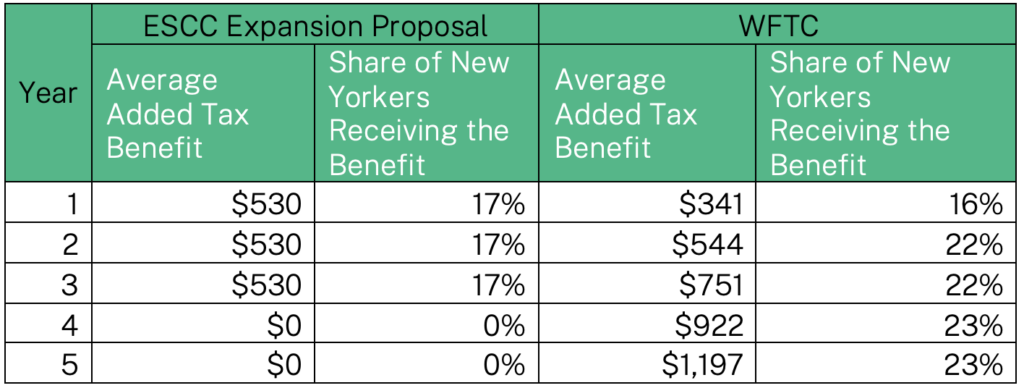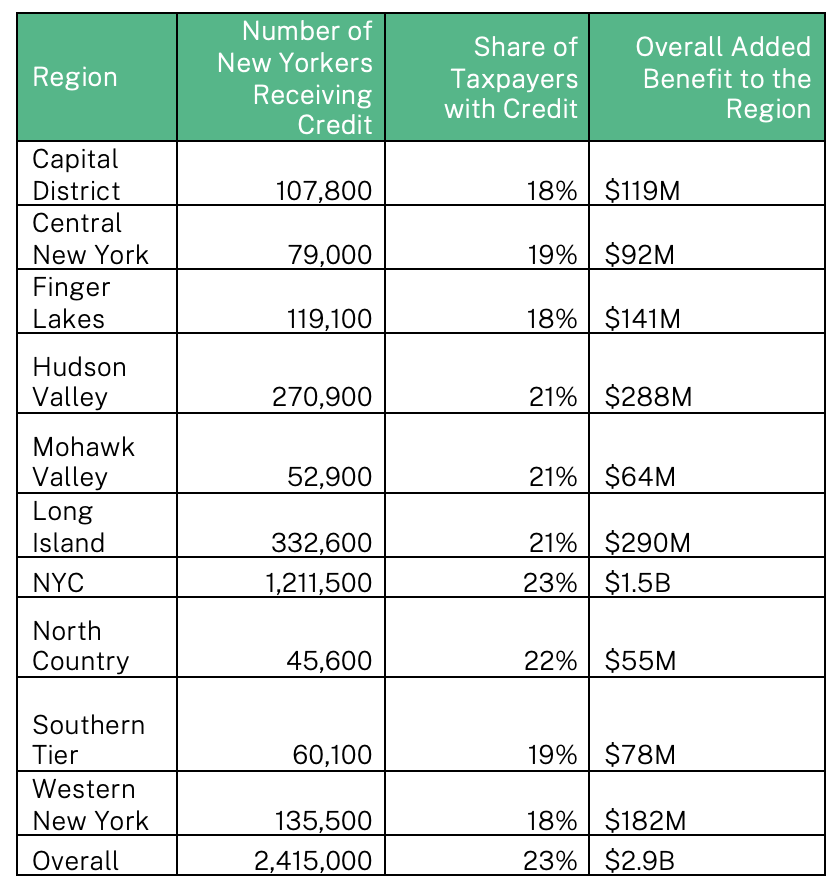A Better Solution for More New Yorkers: Working Families Tax Credit vs. ESCC
Across the state, New Yorkers have struggled to afford an ever-increasing cost of living. While New York has a high median income, it also has an extraordinary level of income inequality, with both large concentrations of millionaires and some of the highest child poverty rates in the country. That makes it all the more urgent to modernize and expand the tax credits aimed at putting more money in the pockets of New York’s working class families.
In January, 2025, New York Governor Kathy Hochul proposed a temporary expansion to the Empire State Child Credit (ESCC) that would provide an average added annual benefit of $530 per family to low- and moderate-income New Yorkers for three years. That would be a great step in the right direction when it comes to putting money in New Yorkers’ pockets and working to end child poverty in the state, and would cover 17 percent of all New York taxpayers. Even still, we can do more to reduce child poverty in the long run and create a sustainable tax benefit for more New Yorkers.
An even better solution is the Working Families Tax Credit (WFTC), which would combine the Empire State Child Credit and Earned Income Tax Credit, as well as making other changes to the tax code, to create one, cohesive benefit. This simplified and expanded single credit would serve millions of New Yorkers.
The highlights of the WFTC include:
- Increasing the maximum credit to $1,600 per child for the lowest income New Yorkers
- A minimum credit of $500 per child for all low- and middle-income families
- Eliminating the harmful wage minimum in the current system that keeps many families from receiving any benefits
- Creating a permanent solution that does not disappear after three years
The Working Families Tax Credit would go beyond the ESCC by removing exclusions for parents of older teens, and the lowest-income families, and it would go beyond the EITC by including ITIN filers. And, as the Niskanen Center observes, “By doubling the phaseout threshold for married couples, streamlining the phaseout rate…, and phasing credits down but not out altogether, the WFTC substantially reduces work and marriage penalties for families.” Overall, the Working Families Tax Credit would cover 23 percent of tax filers, with an average additional benefit of $1,200 by the time it is fully phased in in 2029, according to an analysis prepared for Immigration Research Initiative by the Institute for Taxation and Economic Policy.
Understanding the Proposed ESCC Expansion
Gov. Hochul’s proposal recognizes the need for expansion of the Empire State Child Credit. In addition to temporarily raising the maximum credit from $330 to $500 per child ages five and older, the governor’s proposal would also provide a temporary credit of up to $1,000 per child for children under four. Over the course of the proposed 3-year plan, millions of New Yorkers could receive thousands of dollars in added benefits. That said, there are some clear pitfalls in the ESCC expansion proposal.
The proposal has four main problems: it’s not big enough, it’s not permanent, it misses people who are excluded from the ESCC, and it only looks at the ESCC without also considering the Earned Income Tax Credit.
The expansion from a maximum credit of $330 to $500 per child would be the first boost to the ESCC since its inception in 2006. In effect, this would serve as a one-time inflation adjustment to the Empire State Child Credit.
The fact that the proposal is temporary also significantly limits its appeal. In three years, it will expire. As a result, the plan fails to provide a long-term solution to the problems it sets out to solve.
The bulk of the benefits in Hochul’s plan are aimed at children under four years old. While that is a very appropriate segment of the population to target, it ignores millions of other children who stand to benefit from a more expansive tax credit plan. Most notable are older teens, like 17-year-olds, who are cut of out the Empire State Child Credit entirely.
Finally, the ESCC expansion proposal misses the opportunity to address shortcomings in the other key support for low- and moderate-income families, the Earned Income Tax Credit, which also reaches working people without children.
Why We Need a Working Families Tax Credit
The better solution to child poverty and affordability in New York is the Working Families Tax Credit. In addition to providing a larger average benefit to more New Yorkers, the WFTC will act as a long-term, sustainable expansion of both the ESCC, and the state Earned Income Tax Credit.
By combining the ESCC and EITC into one comprehensive tax credit, the WFTC will be able to provide a much larger average benefit to a wider net of New York tax filers. According to data from the Institute on Taxation and Economic Policy, the WFTC will provide an average tax credit of $1,197 (rounded here to $1,200) to 23 percent of all tax filers in New York after the five-year phase in period.
What’s more, the WFTC is a permanent tax credit that would last longer than the governor’s plan. Figure 1, below, shows how the two plans stack up against one another over the course of five years.
THE WFTC WOULD PROVIDE A BIGGER AVERAGE TAX BENEFIT TO MORE NEW YORKERS

Figure 1: Institute on Taxation and Economic Policy analysis of ESCC expansion and WFTC.
State Costs, Statewide Benefits
New Yorkers have struggled with child poverty and a lack of affordability for too long. Gov. Hochul’s proposal offers a great start to fixing those issues, but we can do better with a Working Family Tax Credit.
The expansion of the ESCC alone would cost $481 million for each of the three years it is in place. The Working Families Tax Credit would be phased in over a period of five years. In the first year, it would cost $586 million, which is just slightly higher than the ESCC proposal. It would increase by about $500 million per year, until reaching a fully phased in amount of $2.9 billion annually. To put that in context, $2.9 billion is roughly 1 percent of the state’s overall budget.
That money would be well spent, and the WFTC would provide a tremendous benefit to every region of New York State.
The table below shows how the benefits to New Yorkers would be spread throughout the state. The Working Families Tax Credit would result in an additional $2.9 billion in benefits to New Yorkers, with benefits in every region of the state. Since the tax credit is designed to help families cover their expenses, it also represents added spending that gives a boost to local grocery stores, clothes shops, and other businesses.
For example, the Working Families Tax Credit would bring an injection of $119 million to the local economy of the Capital District, $92 million to Central New York, and $141 million to the Finger Lakes. For all of the regions of the state, see the figure below.
EVERY REGION OF NEW YORK STATE WOULD SEE AN ECONOMIC INFUSION

Figure 2: Institute on Taxation and Economic Policy analysis of WFTC.